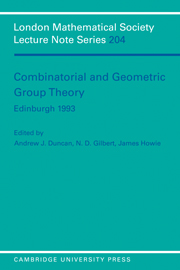Book contents
- Frontmatter
- Contents
- Foreword
- Participants
- On bounded languages and the geometry of nilpotent groups
- Finitely presented groups and the finite generation of exterior powers
- Semigroup presentations and minimal ideals
- Generalised trees and Λ-trees
- The mathematician who had little wisdom: a story and some mathematics
- Palindromic automorphisms of free groups
- A Freiheitssatz for certain one-relator amalgamated products
- Isoperimetric functions of groups and exotic cohomology
- Some embedding theorems and undecidability questions for groups
- Some results on bounded cohomology
- On perfect subgroups of one-relator groups
- Weight tests and hyperbolic groups
- A non-residually finite, relatively finitely presented group in the variety N2A
- Hierarchical decompositions, generalized Tate cohomology, and groups of type (FP)∞
- Tree-lattices and lattices in Lie groups
- Generalisations of Fibonacci numbers, groups and manifolds
- Knotted surfaces in the 4-sphere with no minimal Seifert manifolds
- The higher geometric invariants of modules over Noetherian group rings
- On calculation of width in free groups
- Hilbert modular groups and isoperimetric inequalities
- On systems of equations in free groups
- Cogrowth and essentiality in groups and algebras
- Regular geodesic languages for 2-step nilpotent groups
- Finding indivisible Nielsen paths for a train track map
- More on Burnside's problem
- Problem Session
A non-residually finite, relatively finitely presented group in the variety N2A
Published online by Cambridge University Press: 05 April 2013
- Frontmatter
- Contents
- Foreword
- Participants
- On bounded languages and the geometry of nilpotent groups
- Finitely presented groups and the finite generation of exterior powers
- Semigroup presentations and minimal ideals
- Generalised trees and Λ-trees
- The mathematician who had little wisdom: a story and some mathematics
- Palindromic automorphisms of free groups
- A Freiheitssatz for certain one-relator amalgamated products
- Isoperimetric functions of groups and exotic cohomology
- Some embedding theorems and undecidability questions for groups
- Some results on bounded cohomology
- On perfect subgroups of one-relator groups
- Weight tests and hyperbolic groups
- A non-residually finite, relatively finitely presented group in the variety N2A
- Hierarchical decompositions, generalized Tate cohomology, and groups of type (FP)∞
- Tree-lattices and lattices in Lie groups
- Generalisations of Fibonacci numbers, groups and manifolds
- Knotted surfaces in the 4-sphere with no minimal Seifert manifolds
- The higher geometric invariants of modules over Noetherian group rings
- On calculation of width in free groups
- Hilbert modular groups and isoperimetric inequalities
- On systems of equations in free groups
- Cogrowth and essentiality in groups and algebras
- Regular geodesic languages for 2-step nilpotent groups
- Finding indivisible Nielsen paths for a train track map
- More on Burnside's problem
- Problem Session
Summary
Residually finite varieties of groups were completely described, in [1], by Ol'shanskii. He proved that a group variety is residually finite if and only if it is generated by a finite group with abelian Sylow subgroups.
The next question is: “Which varieties are locally residually finite?” Hall [9] proved that all finitely generated abelian-by-nilpotent groups are residually finite. Hall formulated a conjecture that his result can be extended to the class of abelian-by-poly cyclic groups. Jategaonkar [2] proved that finitely generated abelian-by-polycyclic groups are residually finite.
The following result was obtained by Groves [8]. Let Tp be the variety generated in the variety ℬpA by all 2-generated groups belonging to ZA2, (p an odd prime), and let T2 be the variety generated in the variety A by all 2-generated groups belonging to ZA2A.
Theorem 1(Groves) If W is a variety of metanilpotent groups then the following conditions are equivalent.
W does not contain any Tp.
W is locally residually finite.
All finitely generated groups in W satisfy the maximal condition for normal subgroups.
In [4] it was proved that for odd primes p the variety Tp coincides with ZA2 ∩ ℬpA, and T2 was also described in the language of identities.
Conjecture 1The only minimal, non-locally residually finite, varieties of solvable groups are the varieties from the previous theorem and the varieties ApAqA (p, q are distinct primes).
- Type
- Chapter
- Information
- Combinatorial and Geometric Group Theory, Edinburgh 1993 , pp. 184 - 189Publisher: Cambridge University PressPrint publication year: 1994
- 1
- Cited by



